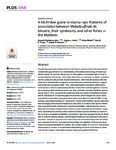A hitchhiker guide to manta rays: Patterns of association between Mobula alfredi, M. birostris, their symbionts, and other fishes in the Maldives
| dc.contributor.author | Nicholson-Jack, AE | en |
| dc.contributor.author | Harris, JL | en |
| dc.contributor.author | Ballard, K | en |
| dc.contributor.author | Turner, KME | en |
| dc.contributor.author | Stevens, GMW | en |
| dc.date.accessioned | 2021-08-09T10:14:00Z | |
| dc.date.issued | 2021-07-14 | en |
| dc.identifier.issn | 1932-6203 | en |
| dc.identifier.uri | http://hdl.handle.net/10026.1/17419 | |
| dc.description.abstract |
<jats:p>Despite being among the largest and most charismatic species in the marine environment, considerable gaps remain in our understanding of the behavioural ecology of manta rays (<jats:italic>Mobula alfredi</jats:italic>, <jats:italic>M</jats:italic>. <jats:italic>birostris</jats:italic>). Manta rays are often sighted in association with an array of smaller hitchhiker fish species, which utilise their hosts as a sanctuary for shelter, protection, and the sustenance they provide. Species interactions, rather than the species at the individual level, determine the ecological processes that drive community dynamics, support biodiversity and ecosystem health. Thus, understanding the associations within marine communities is critical to implementing effective conservation and management. However, the underlying patterns between manta rays, their symbionts, and other hitchhiker species remain elusive. Here, we explore the spatial and temporal variation in hitchhiker presence with <jats:italic>M</jats:italic>. <jats:italic>alfredi</jats:italic> and <jats:italic>M</jats:italic>. <jats:italic>birostris</jats:italic> throughout the Maldives and investigate the factors which may influence association using generalised linear mixed effects models (GLMM). For the first time, associations between <jats:italic>M</jats:italic>. <jats:italic>alfredi</jats:italic> and <jats:italic>M</jats:italic>. <jats:italic>birostris</jats:italic> with hitchhiker species other than those belonging to the family Echeneidae are described. A variation in the species of hitchhiker associated with <jats:italic>M</jats:italic>. <jats:italic>alfredi</jats:italic> and <jats:italic>M</jats:italic>. <jats:italic>birostris</jats:italic> was identified, with sharksucker remora (<jats:italic>Echeneis naucrates</jats:italic>) and giant remora (<jats:italic>Remora remora)</jats:italic> being the most common, respectively. Spatiotemporal variation in the presence of manta rays was identified as a driver for the occurrence of ephemeral hitchhiker associations. Near-term pregnant female <jats:italic>M</jats:italic>. <jats:italic>alfredi</jats:italic>, and <jats:italic>M</jats:italic>. <jats:italic>alfredi</jats:italic> at cleaning stations, had the highest likelihood of an association with adult <jats:italic>E</jats:italic>. <jats:italic>naucrates</jats:italic>. Juvenile <jats:italic>E</jats:italic>. <jats:italic>naucrates</jats:italic> were more likely to be associated with juvenile <jats:italic>M</jats:italic>. <jats:italic>alfredi</jats:italic>, and a seasonal trend in <jats:italic>E</jats:italic>. <jats:italic>naucrates</jats:italic> host association was identified. <jats:italic>Remora</jats:italic> were most likely to be present with female <jats:italic>M</jats:italic>. <jats:italic>birostris</jats:italic>, and a mean number of 1.5 ± 0.5 <jats:italic>R</jats:italic>. <jats:italic>remora</jats:italic> were observed per <jats:italic>M</jats:italic>. <jats:italic>birostris</jats:italic>. It is hoped these initial findings will serve as the basis for future work into the complex relationships between manta rays and their hitchhikers.</jats:p> | en |
| dc.language | en | en |
| dc.language.iso | en | en |
| dc.publisher | Public Library of Science | en |
| dc.rights | Attribution-NonCommercial-NoDerivatives 4.0 International | en |
| dc.rights | Attribution-NonCommercial-NoDerivatives 4.0 International | en |
| dc.rights | Attribution-NonCommercial-NoDerivatives 4.0 International | en |
| dc.rights | Attribution-NonCommercial-NoDerivatives 4.0 International | en |
| dc.rights | Attribution-NonCommercial-NoDerivatives 4.0 International | en |
| dc.rights | Attribution-NonCommercial-NoDerivatives 4.0 International | en |
| dc.rights.uri | http://creativecommons.org/licenses/by-nc-nd/4.0/ | en |
| dc.rights.uri | http://creativecommons.org/licenses/by-nc-nd/4.0/ | en |
| dc.rights.uri | http://creativecommons.org/licenses/by-nc-nd/4.0/ | en |
| dc.rights.uri | http://creativecommons.org/licenses/by-nc-nd/4.0/ | en |
| dc.rights.uri | http://creativecommons.org/licenses/by-nc-nd/4.0/ | en |
| dc.rights.uri | http://creativecommons.org/licenses/by-nc-nd/4.0/ | en |
| dc.title | A hitchhiker guide to manta rays: Patterns of association between Mobula alfredi, M. birostris, their symbionts, and other fishes in the Maldives | en |
| dc.type | Journal Article | |
| plymouth.issue | 7 | en |
| plymouth.volume | 16 | en |
| plymouth.journal | PLoS One | en |
| dc.identifier.doi | 10.1371/journal.pone.0253704 | en |
| plymouth.organisational-group | /Plymouth | |
| plymouth.organisational-group | /Plymouth/Faculty of Science and Engineering | |
| plymouth.organisational-group | /Plymouth/Users by role | |
| plymouth.organisational-group | /Plymouth/Users by role/Academics | |
| dcterms.dateAccepted | 2021-06-11 | en |
| dc.rights.embargodate | 2021-08-10 | en |
| dc.identifier.eissn | 1932-6203 | en |
| dc.rights.embargoperiod | Not known | en |
| rioxxterms.versionofrecord | 10.1371/journal.pone.0253704 | en |
| rioxxterms.licenseref.uri | http://creativecommons.org/licenses/by-nc-nd/4.0/ | en |
| rioxxterms.licenseref.startdate | 2021-07-14 | en |
| rioxxterms.type | Journal Article/Review | en |



